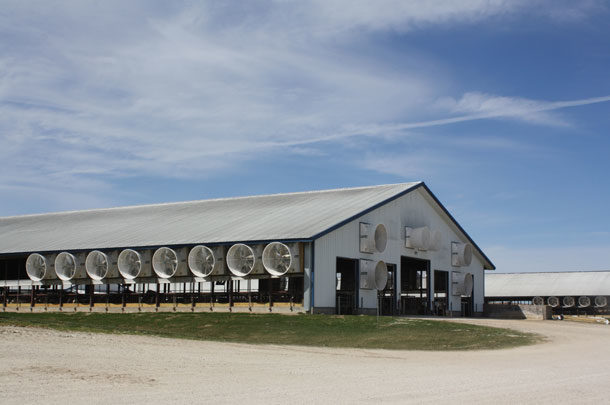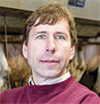Properly designed ventilation systems are important for animal health, well-being and production. The ventilation system removes heat, humidity and gasses while providing fresh air for the animals.
In the summer, the primary purpose of the ventilation system is to remove as much heat as possible. Many farms have inadequate summer ventilation systems and the cows experience heat stress. A well designed, well maintained summer ventilation system will make the most efficient use of energy while maximizing milk production and animal well-being.
Temperature-humidity index (THI) is a common indicator for the degree of heat stress in livestock. The latest research estimates that heat stress on dairy cows begins when the THI reaches 68. In a later study, they reported that lactating dairy cows producing more than 77 pounds of milk begin to have milk yield losses when the minimum THI is 65 or greater or when the average THI is 68 or more for more than 17 hours per day.
Summers throughout North America are becoming warmer and more humid. Nighttime temperatures are staying higher. As dairy cows increase in production, they also increase heat production due to digestion of increased amounts of food. These two factors have resulted in increased heat stress on our dairy cows. Below are some of the animal welfare and performance impacts of an inadequate summer ventilation system.
Heat stress impacts
In response to heat stress, dairy cows exhibit behavioral changes. A study showed that lying time decreased from 10.93 hours per day when the THI was 56 to 7.91 hours when the THI increased to 73.8. In this study, the cows were generally spending more time standing in the alleys. Observations also indicate that cows under heat stress are more likely to stand and bunch together in certain areas of the barn.
Heat stressed cows have increased respiration rates and often pant in an attempt to dissipate heat. This, along with decreased saliva production because of less rumination, can result in an increase in subacute rumen acidosis (SARA). The combination of increased standing and metabolic acidosis can result in increased lameness for several months after the heat stress occurred.
High producing cows experience more heat stress than lower producing cows. Research shows that at similar THI levels, high producing cows’ body temperatures will increase more than low producing cows’ temperatures. Further, heat stress adversely affects reproduction by reducing heat expression, decreasing embryo quality and impairing immune function. Negative impacts are also observed when dry cows are subjected to heat stress.
Evaluating your ventilation system
Evaluating the ventilation system is an important first step. Ask yourself these questions:
- Are the fans running, and running according to the appropriate temperature and time schedule?
- Are mixing fans directing air towards the cows rather than above them?
- Are there noticeable and appropriate air speed differences in different parts of the barn?
- Are heat stress behavior indicators more prevalent in one part of the barn than another?
Identifying and addressing these types of issues within your current system can help you use your energy more efficiently.
Two keys to maximizing the energy efficiency of your ventilation are fan selection and maintenance. When purchasing and installing fans, it is important to consider how energy efficient they are. The University of Illinois BESS lab conducts independent third party testing of agricultural ventilating and circulating fans. Test results are available online.
BESS lab reports the performance parameters, including ventilation efficiency ratings in cubic feet per minute (CFM) per watt, for the various fan makes and models. There is wide variation in energy efficiency of fans. For example, BESS lab reports the energy efficiency ratings of 48-inch fans ranges from 12.7 to 23.4 CFM per watt. Proper maintenance of the ventilation system is important to optimize performance. Research has shown that dusty and dirty shutters and blades can reduce fan flow rates up to 40 percent. Matching and designing the inlet area to match fan output will maximize air for the amount of energy used.
BESS lab also tests and reports circulating fan performance and energy use. An important parameter for circulating fans is thrust efficiency ratio – that indicates how efficiently the fan transfers electrical power into air movement. They also report centerline air velocities at standard distances downstream of a circulating fan. Thrust efficiency ratios for 36-inch fans range from 10.4 to 22.4 pounds of force (lbf) per kW, and centerline velocities at 15 feet downstream range from 560 to 1,540 feet per minute. This is a large range for one size of fan! PD
References have been omitted but are available upon request. Click here to email an editor.
Jim Salfer is with the University of Minnesota Extension; Erin Cortus is from South Dakota State University; and Kevin Janni is from University of Minnesota.
PHOTO: There are ways to save energy while cooling cows this summer. Photo by Peggy Coffeen.






